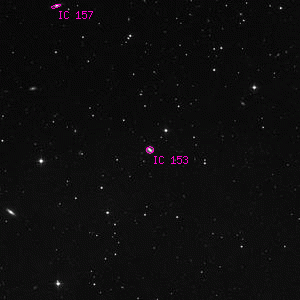IC 153

Overlaid DSS image of IC 153, 30' x 30' with north at top and west to the right
Aladin viewer for the region around IC 153
Mrk 575, UGC 1260, PGC 6633
| Type | Galaxy |
|---|---|
| Magnitude | 14 |
| Size | 0.753' x 0.618' @ 95° |
| Right Ascension | 1h 48' 33.1" (2000) |
| Declination | 12° 36' 50" N |
| Constellation | Aries |
| Classification | SBa |
Observing Notes
Harold Corwin
Steve Gottlieb has suggested that this is probably UGC 1260, and IC 157 is probably UGC 1274. In an email in April 2017, he writesI was just taking a look at IC 153 and 157, two Swift discoveries on 25 Sep 1890. There's nothing at his positions and everyone has concluded "Not found". But I noticed that if he made 4 minute errors in recording or transcribing the RA, then it's possible IC 153 = UGC 1260 and IC 157 = UGC 1274, as the declinations are a pretty good match.Swift's descriptions in this case are not very helpful, but he does say this about IC 157:"D * and wide D p, nf of 2." Do these comments apply to UGC 1274? Well, about 8[arcmin] northwest of UGC 1274 is a 10th magnitude star (SAO 92644) that does have a wide companion, and also 8[arcmin] southwest is a closer and fainter double star. So, I think these conditions are met.The RA differences with Swift's positions are just 4 minutes of time for IC 153, and 3.5 minutes for IC 157, while the Dec differences are about an arcminute in both cases. Given that Swift's description of the double stars west of IC 157 is accurate, I think that Steve has found the correct galaxies. Nevertheless, usual caution suggests colons on the IC numbers in the position tables.
Also see IC 151 for a similar solution for another pair of galaxies in the same part of the sky, also found by Swift late in the summer of 1890.
Other Data Sources for IC 153
Nearby objects for IC 153
Credits...
Drawings, descriptions, and CCD photos are copyright Andrew Cooper unless otherwise noted, no usage without permission.
A complete list of credits and sources can be found on the about page
IC 153